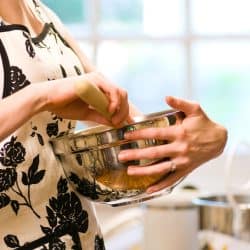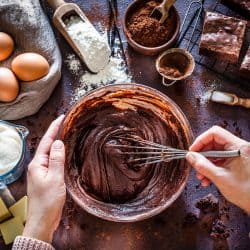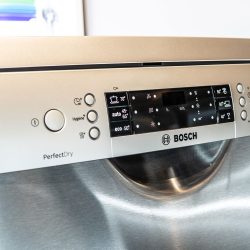Mixing bowls are a staple item in any kitchen. But, when you want to grab the right bowl for the job, how do you know what type of mixing bowl to pick?

Many types of materials are used to make mixing bowls. Choosing the right material for your bowl, or set of bowls can make a big difference in how you use and maintain the bowl. The correct mixing bowl can help you cook with ease and adds an aesthetically pleasing item to your kitchen’s cookware.
Contents
We’ve looked closely at different types of mixing bowl materials to learn about the pros and cons of each type. Keep reading to determine what type of mixing bowl is the best fit for your kitchen.
Stainless Steel Mixing Bowls
As an affordable, long-term investment to your kitchen, a stainless steel mixing bowl is practically indestructible. Easy to clean and multipurpose, a stainless steel bowl can last a lifetime.
Click here to find this set of stainless bowls by ChefLand on Amazon.
Pros
- Lightweight.
- Dishwasher safe.
- Multipurpose; used as a double boiler, serving bowl, and food storage.
- Unbreakable.
- Nesting storage.
Cons
- Not microwave safe.
- Industrial design.
Glass Mixing Bowls
Tempered glass is a tried-and-true bakeware material. Glass mixing bowls are easy to clean and serve as a multipurpose addition to your kitchen.
Click here to find this set by Pyrex on Amazon.
Pros
- Microwave safe.
- Dishwasher safe.
- Oven safe.
- Multipurpose; used as a double boiler, serving bowl, and food storage.
- Nesting storage.
Cons
- Heavy.
- Breakable.
- Plain design.
Ceramic Mixing Bowls
Add style to your kitchen, with the available colors, and raised patterns of ceramic mixing bowls. A solid choice for mixing, ceramic bowls can also be multipurpose as decorative fruit bowls and serving bowls atop your counter.
Click here to find this bowl set by KooK on Amazon.
Pros
- Microwave safe.
- Dishwasher safe.
- Oven safe.
- Multipurpose; used as a serving bowl and food storage.
- Nesting storage.
Cons
- Heavy.
- Breakable; prone to chipping and glaze cracking,
Plastic (Acrylic/Melamine) Mixing Bowls
If you want a bowl that can express your creative side, and won’t let you down in terms of longevity, plastic mixing bowls come in a variety of colors and patterns to add some pizazz to functional bakeware.
Click here to find this set of bowls by OXO on Amazon.
Pros
- Lightweight
- Microwave safe.
- Dishwasher safe.
- Difficult to break.
- Multipurpose; used as food storage and as a serving bowl.
- Nesting storage.
Cons
- Can melt/warp if exposed to direct heat.
- Can discolor.
- Absorbent material; lingering odors/flavors.
- Soft material; prone to scratches.
Silicone Mixing Bowls
Virtually unbreakable, if you add a colorful silicone mixing bowl to your kitchen, it can outlast most of your bakeware.
Click here to find this bowl set by Le Creuset on Amazon.
Pros
- Lightweight.
- Collapsable and nesting storage.
- Microwave safe.
- Dishwasher safe.
- Oven safe.
- Multipurpose; use as a serving bowl, or for food storage.
Cons
- Flimsy, for brisk stirring and pouring.
- Absorbent material; lingering flavors/odors.
Copper Mixing Bowls
A timeless choice, copper mixing bowls bring a classic look into your kitchen. Professional chefs most commonly use copper as a tool for whipping egg whites because the copper chemically reacts with the egg to produce stiffened whites. As a mixing bowl, used at home, you might find it is not the most versatile material.
Click here to find this bowl by Old Dutch International on Amazon.
Pros
- Lightweight.
- Unbreakable.
- Dishwasher safe.
- Multipurpose; use as a double boiler, or serving bowl.
- Nesting storage.
Cons
- Expensive.
- Can discolor.
- Not microwave safe.
- Reactive material; influences the flavor of foods.
- Prone to staining from acidic foods.
Aluminum Mixing Bowls
Aluminum is not often chosen as a material used for mixing bowls because it is a soft, reactant metal that can influence the taste of your foods. It’s challenging to find aluminum mixing bowls.
As an excellent heat conductor, aluminum is typically used for pots, pans, and bakeware. We suggest using non-abrasive utensils with aluminum cookware to avoid scratches and flavor interactions.
Click here to find this cookware by IMUSA on Amazon.
Pros
- Lightweight.
- Unbreakable.
- Dishwasher safe.
- Multipurpose; use as a double boiler.
- Nesting storage.
Cons
- Not microwave safe.
- Reactive material; influences the flavor of foods.
- Prone to staining from acidic foods.
- Soft material; prone to scratches, and potential to add minuscule aluminum shavings to food.
Brushed Steel Mixing Bowls
Get the benefits (and downsides) of stainless steel, with an aesthetically pleasing finish. Brushed steel mixing bowls are crafted from stainless steel and then given a dull, matte finish to remove the shine by brushing or sanding with a fine bristle brush.
Click here to find this set of bowls by finedine on Amazon.
Silver Mixing Bowls
Elegant, sterling silver is made from 92.5% silver and other alloys such as copper. Silver is rarely used as a mixing bowl material. However, it is traditionally used as a material for serving bowls, serving platters, and flatware.
If you can find a silver mixing bowl, it is likely to be made from multi-metal alloy or stainless steel with a polished finish.
Click here to find this bowl by Nambe on Amazon.
Pros
- Aesthetic value.
Cons
- Expensive.
- Heavy.
- Not dishwasher safe.
- Not microwave safe.
- Requires polishing.
- Prone to staining, or tarnish, from acidic and sulfuric foods.
- Soft material; easily scratched.
As you’ve just learned, several types of mixing bowls are multifunctional and can also be used as serving bowls. Check out our blog, “How Big Should a Serving Bowl Be,” for the best size bowls to use for both foodservice and display.
Can I Use a Wooden Bowl as a Mixing Bowl?
Natural, rustic wooden bowls are practical to use in your kitchen but require a bit of extra care. Usually, wooden bowls are used for serving food, or to display as a centerpiece, rather than mixing up ingredients. We recommend using non-abrasive utensils with your wooden bowls.
Click here to find this bowl by Lipper International on Amazon.
Pros
- Lightweight.
- Unbreakable.
- Multipurpose; used as a serving bowl.
- Nesting storage.
Cons
- Not microwave safe.
- Not dishwasher safe.
- Requires seasoning.
- Can crack/warp/splinter if exposed to direct heat.
- Absorbent material; lingering flavors and odors.
- Soft material; prone to scratches.
Now that you’ve determined the mixing bowl material that will coordinate best with your cooking techniques and kitchen style, check out KitchenSeer.com for the best utensils to use with your mixing bowls.















![Kitchen utensils in containers on table, Kitchen Utensils: The Ultimate List [Do You Know All 56?]](https://kitchenseer.com/wp-content/uploads/2020/05/Kitchen-utensils-in-containers-on-table-250x250.jpg)
